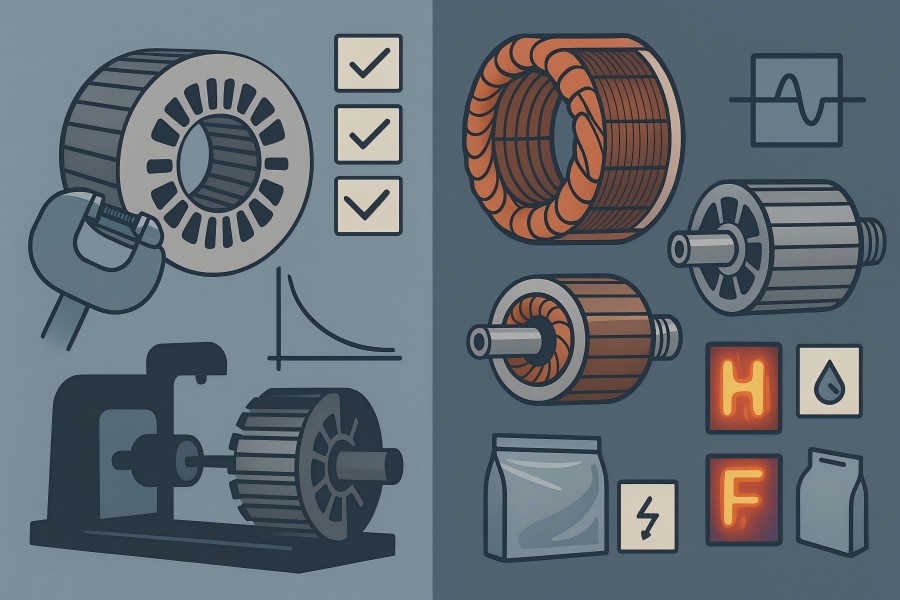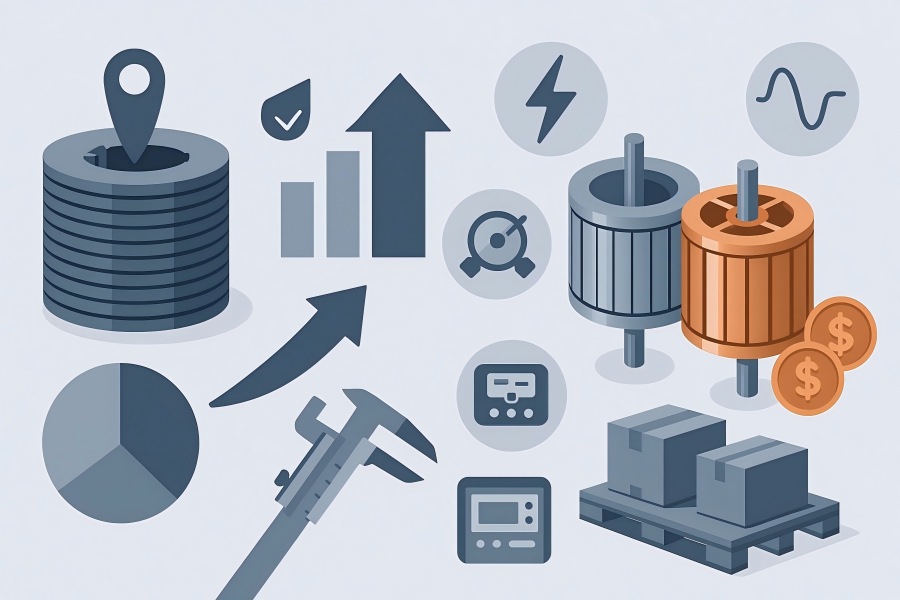Buying stator and rotor assemblies is an important decision: the wrong core steel, tolerances, or insulation can lock in losses and reliability issues for years. Use these ten questions to evaluate suppliers and secure robust, efficient parts.
What efficiency target and duty profile are you designing for?
Before discussing steel grades or tolerances, pin down the operating points and efficiency goals across your duty cycle. Induction motors rarely run at a single load/speed; stator/rotor choices should reflect your real profile (continuous, S1; intermittent, S3/S6; or variable-speed with a VFD). Clarify voltage and frequency (e.g., 230/400 V 50 Hz, 460 V 60 Hz), number of poles, frame size, cooling method (IC411/IC416, etc.), and the efficiency class you must hit.
Useful data targets
Typical improvement between efficiency classes at 2–15 kW, 4-pole:
- IE3 vs. IE2: +1.5 to +3.0 percentage points
- IE4 vs. IE3: +1.0 to +2.0 percentage points
Part-load efficiency is as important as full-load; expect a 1–4 point drop at 50–75% load if the design is not optimized for your profile.
No-load current is a good proxy for magnetic design quality; tighter designs reach 20–35% of rated current at no-load (frame-dependent).
| Parameter | Specify/Ask | Typical Range/Note |
| Efficiency class | IE2 / IE3 / IE4 target | Confirm by power & poles |
| Load profile | % time at 25/50/75/100% load | Drives losses optimization |
| Voltage & frequency | e.g., 460 V, 60 Hz | Tolerances ±10% V, ±5% Hz |
| Poles/speed | 2/4/6/8 poles | Impacts steel choice & skew |
| Cooling & enclosure | IC411, IC416; IP rating | Influences temperature rise |
Which lamination steel grade and thickness will you use—and what core loss do you guarantee?
Core steel selection dominates magnetizing current, core loss, and thermal rise. Ask suppliers to quote specific core loss (W/kg) at a stated induction and frequency (e.g., 1.5 T, 50/60 Hz) and to declare lamination thickness and coating.
Data points and expectations
- Thinner laminations (0.35 mm vs. 0.50 mm) typically cut core loss by ~10–25% at the same flux density.
- Stacking factor ≥0.96 is common for premium stacks; burr height ≤0.02 mm reduces inter-lamination shorts.
- Insulation coating class (C3/C5 or equivalent) affects inter-lamination resistance and punchability.
| Attribute | Option / Value | Typical Benefit / Trade-off |
| Lamination thickness | 0.50 mm / 0.35 mm / 0.27 mm | Thinner → lower loss, higher cost |
| Specific core loss (1.5 T, 50 Hz) | ~7–10 W/kg (0.50 mm) / ~5–8 W/kg (0.35 mm) | Lower loss → higher efficiency |
| Relative permeability (μr) | 1200–2000 | Impacts magnetizing current |
| Stacking factor | ≥0.96 | Real iron fraction in stack |
| Burr height after stamping | ≤0.02 mm | Limits shorted laminations |
| Lamination coating | Organic/inorganic, C3–C5 | Electrical isolation, punch wear |
Request mill certificates and batch traceability for every steel coil used.
What slot geometry and winding method will you deliver—and what slot fill factor do you commit to?
Slot geometry (open vs. semi-closed), tooth width, and the winding process (manual random wound, needle wound, form-wound) drive copper utilization, heat, and noise.
Quantitative targets
- Slot fill factor (copper cross-section vs. slot area): 40–55% is typical for random wound; >55% for form-wound coils in larger frames.
- End-winding overhang: often 0.8–1.4× stack height; minimizing overhang reduces copper loss and improves cooling.
- Conductor temperature index: select to match insulation class (Class F 155 °C, Class H 180 °C).
| Item | Typical Choices | Numbers to Pin Down |
| Winding type | Random/needle / Form-wound | Fill factor target (≥45%) |
| Connection | Star/Delta; 6/9/12 leads | Starting/line voltage options |
| Wire spec | Enamel grade, inverter-duty | Thermal index ≥155 °C (F) |
| End-turn overhang | Compact vs. standard | mm or % of stack height |
| Slot liner & wedges | Nomex, DMD, glass | Thickness & class ratings |
Ask the supplier to provide slot fill calculations, overhang dimensions, and winding diagrams with coil pitch and groupings.
Which rotor technology: die-cast aluminum or copper bar/ring—and what skew angle?
Rotor resistance and leakage dictate torque, slip, and efficiency. Aluminum die-cast rotors dominate volume markets; copper bar & end ring (“fabricated copper”) can lift efficiency at higher material cost.
Comparative data
| Property | Aluminum Die-Cast | Copper Bar & Ring |
| Electrical resistivity (20 °C) | ~2.82×10⁻⁸ Ω·m | ~1.68×10⁻⁸ Ω·m |
| Typical efficiency impact | Baseline | +0.5 to +2.0 points |
| Starting torque | Good | Very good (with design tuning) |
| Cost & weight | Lower | Higher |
| Thermal conductivity | Lower | Higher (better heat spreading) |
| Casting/assembly | One-shot casting | Bars + brazed/soldered rings |
Skew (to mitigate torque ripple & acoustic noise): common values are 0.5–1.0 slot pitch. Excessive skew increases leakage and reduces torque—ask for the skew angle and the expected torque ripple (%).
What dimensional tolerances, runout, and balance grade will you guarantee?
Mechanical precision is critical for low vibration, low noise, and bearing life. Require a drawing package with geometric dimensioning & tolerancing (GD&T) and a balance plan.
Typical precision targets
| Feature | Typical Tolerance / Spec | Notes |
| Stator OD / ID | ±0.02–0.05 mm (stack ground) | Influences frame fit, air-gap |
| Stack height | ±0.05–0.10 mm | Affects back iron flux path |
| Slot width | ±0.02 mm | Drives fill, leakage |
| Rotor shaft press fit | H7/k6 or H7/m6 | Confirm interference (µm) |
| Air-gap uniformity (TIR) | ≤0.03–0.05 mm | Lower noise & losses |
| Dynamic balance grade | ISO 21940 G2.5 (rotor) | G6.3 acceptable for larger units |
| Residual unbalance (example) | Uper ≈ 9540 × G × m / n (g·mm) | n in rpm, m in kg |
Ask for 100% rotor balance reports (speed, planes, correction weights) and TIR measurements at the bearing journals.
What insulation system and temperature class will be used—and what tests will you run?
Thermal headroom and dielectric robustness determine lifetime, especially on VFDs.
Thermal classes & life
| Insulation Class | Max Hot-Spot Temp | Typical Temperature Rise (F) | Life Expectation |
| Class B | 130 °C | 80–90 K | Baseline |
| Class F | 155 °C | 105 K | ~2× vs. B (if run cooler) |
| Class H | 180 °C | 125 K | ~2× vs. F (if run cooler) |
Rule of thumb: every 10 °C reduction in hot-spot temperature can double insulation life.
Electrical tests to demand
- HiPot: phase-to-ground at 2E + 1000 V for 1 minute (E = rated phase voltage).
- Surge test: inter-turn test, pulse peak ≥ rated line-to-line + 500–1000 V (define waveform).
- Insulation resistance (IR): ≥100 MΩ at 40–60 °C after 1 minute at 500 or 1000 VDC (specify).
- Polarization Index (PI): PI ≥ 2.0 recommended.
Record ambient/humidity during tests for apples-to-apples comparisons.
Is the design truly VFD-ready (inverter duty)?
Fast switching (2–20 kHz) creates high dv/dt (often 3–5 kV/µs) and reflected wave overvoltages, stressing turn insulation and bearings.
VFD-readiness checklist
| Area | What to Require | Numbers to Watch |
| Turn insulation | Corona-resistant magnet wire | Verified by surge test limits |
| Phase paper & slot liner | Class F/H, partial discharge-resistant | Thickness & overlaps specified |
| Bearing current mitigation | Insulated NDE bearing or shaft grounding | Spark erosion risk without it |
| Common-mode control | dv/dt filter or sine filter (system-level) | Particularly on long cables |
| Temperature rise | Keep below class limits at carrier freq | Verify at your duty cycle |
Ask for a VFD compatibility statement and test evidence on similar frames/voltages.
What verification tests and acceptance criteria do you include in the FAT (Factory Acceptance Test)?
A strong supplier will propose a measurable FAT plan. Specify test points and tolerances that mirror your duty.
| Test | Condition | Acceptance |
| No-load current & power | Rated V/f, 25 °C | Within ±10% of agreed target |
| Locked-rotor current/torque (type test) | Short-duration | Within design tolerance |
| Efficiency & PF at 25/50/75/100% load | Rated V/f, 25 °C | Meet class targets; curve shape agreed |
| Temperature rise test | Rated load to steady state | ≤ class limit (e.g., 105 K for F) |
| Vibration | ISO 20816 zone A/B | Meet frame-size thresholds |
| Noise (SPL) | Free-field at 1 m | Target by frame & poles |
| HiPot / Surge / IR / PI | As in §6 | Pass/record values |
| Dimensional audit | 100% critical features | OD/ID/slot width, TIR, stack height |
| Rotor balance | At test speed | ISO 21940 G2.5 |
Insist on full test reports with serial-number traceability and raw data logs, not just pass/fail.
How will you control quality, traceability, and engineering changes?
Consistent quality across batches is non-negotiable. Probe the supplier’s process capability and change control.
What to ask for
- Certifications: ISO 9001 minimum; IATF 16949 if automotive; ISO 14001/45001 desirable.
- Incoming steel & copper control: coil heat numbers, lamination coating lot, wire lot.
- Process capability: report Cp/Cpk ≥ 1.33 on key features (slot width, OD/ID, stack height).
- PPM target: set a delivered defect target (e.g., ≤500 PPM) and a 8D corrective action process.
- ECN/PCN process: formal Engineering/Process Change Notices with customer approval for any changes in steel grade, thickness, coating, stamping tool, winding, varnish, cure schedule, or rotor casting parameters.
- Tooling life: define resharpening intervals and criteria (e.g., burr height, slot width drift).
| Quality Item | Evidence to Request |
| Control plan & PFMEA | Approved documents per product |
| Gauge R&R | ≤10% preferred on critical gauges |
| First Article Inspection | Full dimensional layout on 1st lot |
| Traceability | Serial/lot back to steel/wire/varnish |
| SPC charts | On slot width, OD/ID, stack height |
What are your logistics, MOQ, and lifecycle service commitments?
Cost is more than unit price. Clarify lead times, buffer stock, packaging, corrosion control, and EoL support.
| Topic | Typical Data/Targets | Why It Matters |
| MOQ & EOQ | MOQ 200–1000 pcs; EOQ optimized to demand | Impacts cash & flexibility |
| Lead time | 4–10 weeks typical (tooling may add 2–6 weeks) | Align with your ramp plan |
| Safety stock / VMI | 2–4 weeks buffer at supplier or hub | Absorbs demand swings |
| Packaging | VCI paper/bags, desiccant, humidity card | Prevents rust during transit |
| Preservation | VPI varnish cure records; dry-pack | Insulation & corrosion control |
| Labeling | Part no., lot, steel heat, date | Ensures traceability |
| Warranty | 12–24 months typical | Link to test data & usage |
| Last-time buy | 6–12 months notice | Avoids redesign surprise |
Ask for a packaging validation: drop test results, humidity exposure (e.g., 85%RH, 40 °C for 48 h), and arrival inspections from pilot shipments.
Concise datasheet template to request from suppliers
Request a one-page (plus drawings) datasheet so you can compare vendors apples-to-apples.
| Section | Fields to Include |
| Identification | Part number, revision, frame size, poles, frequency, voltage, connection (Y/Δ), rated power |
| Magnetic Stack | Steel grade & thickness, core loss @ 1.5 T 50/60 Hz, stacking factor, burr limit, skew angle |
| Geometry | OD/ID, stack height, slot count/style, tooth width, slot opening, air-gap target, tolerances (GD&T) |
| Windings | Wire gauge/type, insulation class, fill factor, end-turn length, connection diagram, varnish type/cure |
| Rotor | Material (Al die-cast or Cu bar/ring), bar dimensions, end ring spec, skew, balance grade |
| Electrical | No-load current/power, typical efficiency curve points, PF, magnetizing current |
| Tests | HiPot (level/duration), Surge (kV), IR/PI (conditions), vibration/noise limits, balance report |
| Environment | IP rating, cooling method, max ambient, altitude, VFD compatibility statement |
| Quality | Certifications, Cp/Cpk features, traceability fields, ECN/PCN process |
| Logistics | MOQ, lead time, packaging, preservation, warranty, last-time-buy policy |
How to use these questions in supplier conversations
- Start with targets (efficiency class, duty profile) and request a preliminary loss budget (stator copper, rotor copper, iron, stray, friction/windage).
- Pin down materials (steel grade, thickness, coating; copper class) and get testable limits (core loss W/kg, fill factor %, burr mm, TIR mm, balance grade).
- Demand data over promises: a supplier’s prototype test sheet at your voltage/frequency tells you far more than marketing statements.
- Audit the process: see lamination stamping/stacking, rotor casting/brazing, winding, varnish cure logs, balance stands, and final test bays.
- Lock change control: any shift in steel, tools, or winding should trigger re-qualification.




